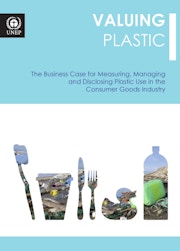
The ‘valuing Plastic’ report looks at the business case for measuring, managing and disclosing plastic use in the consumer goods sector. The objective of this report is to help companies manage the opportunities and risks associated with plastic use.
It articulates the business case for companies to improve their measurement, disclosure and management of plastic use in their designs, operations and supply chains. In order to provide a sense of scale, the report sets out to quantify the physical impacts of plastic use translated into monetary terms.
This metric can be seen as the current value-at-risk to a company, should these external impacts be realised internally through mechanisms like strengthened regulation, loss of market share, or increased price of raw materials and energy. This metric can also be used to help understand the magnitude of the opportunities, and the tangible benefits to stakeholders, including shareholders, of using plastic in an environmentally sustainable way.
Overview
- The analysis identifies a range of risks and opportunities facing companies that are intensive users of plastic, as well as investors.
- The toy, athletic goods and durable household goods sectors use the most plastic in products per US$1 million revenue.
- The retail, restaurant and tobacco sectors use the most plastic per $1m revenue in their supply chains.
- The total natural capital cost of plastic used in the consumer goods industry is over $75bn per year.
- Food companies are by far the largest contributor to this cost, responsible for 23% of the total natural capital cost.
- The toy sector has by far the highest natural capital intensity, at 3.9% of revenue.
- Companies in the food, soft drinks and non-durable household goods sectors have the largest natural capital costs in absolute terms.
- Companies in the toy, athletic goods and footwear sectors have the highest natural capital intensity.
- Over 30% of the natural capital costs come from greenhouse gas emissions released upstream in the supply chain.
- The impacts of plastic vary around the world, based on background conditions and management practices.
- Levels of disclosure on plastic are poor. Only around half of the 100 companies assessed reported at least one item of quantitative data on plastic.
- Currently, there is no correlation between a sector’s disclosure rate and its plastic intensity or absolute natural capital cost due to plastic.
Publish your content with EB Publishing
It's about who you reach. Get your news, events, jobs and thought leadership seen by those who matter to you.









